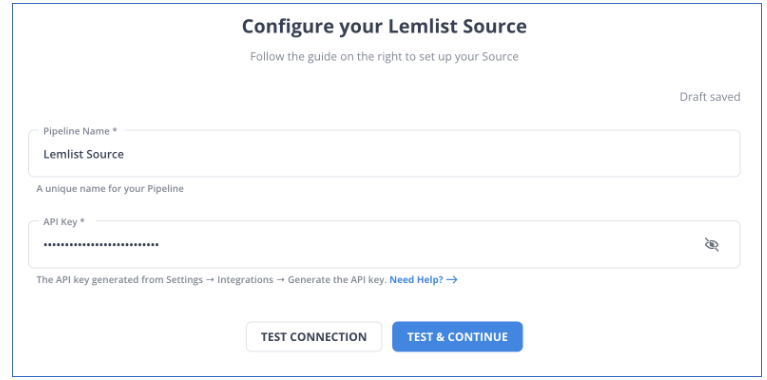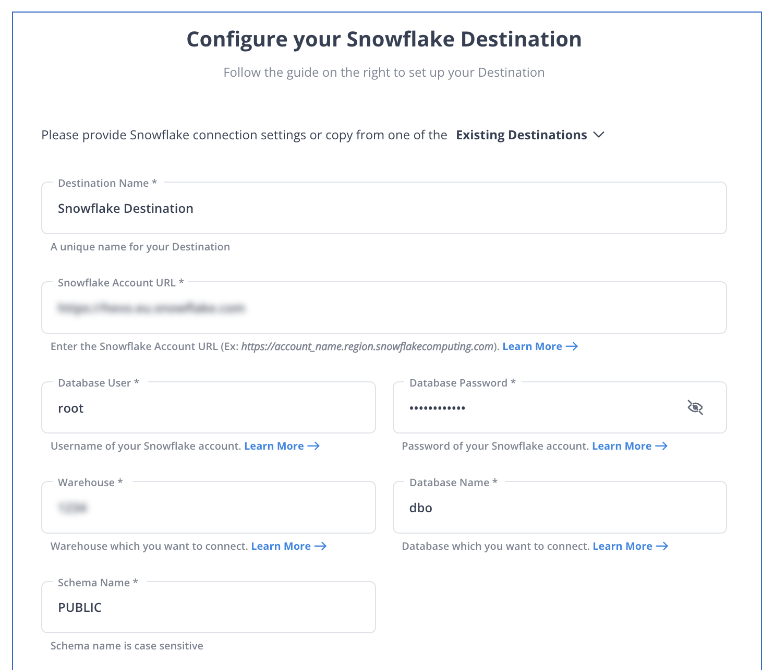As a data engineer, you hold all the cards to make data easily accessible to your business teams. Your marketing team just requested a Lemlist to Snowflake connection on priority. We know you don’t want to keep your data scientists and business analysts waiting to get critical business insights. If this is a one-time thing, exporting data with the help of CSV files is helpful. Or, hunt for a no-code tool that fully automates & manages data integration for you while you focus on your core objectives.
Well, look no further. With this article, get a step-by-step guide to connecting Lemlist to Snowflake effectively and quickly, delivering data to your sales and support teams.
Table of Contents
What is Lemlist?

Lemlist is an all-in-one, cloud-based platform for sales engagement and email outreach, which lets companies automate cold email campaigns and customize each to a great extent, so it is possible to manage follow-ups to get a good response. Majorly, it’s used in sales prospecting, lead generation, and nurturing relationships with potential clients.
Key Features of Lemlist
- Personalized Email Campaigns: Customize emails with dynamic variables and images to create personalized outreach for each recipient.
- Set up automated follow-up sequences based on the recipient’s engagement like opens and clicks.
- Email Deliverability Tools: Tools that warm up email accounts and increase the chances of email landing in an inbox, not spam folders.
- Use A/B Testing: Apply different subject lines, contents, and even strategies for optimizing email campaigns towards greater engagement.
Migrating your data from MySQL on Lemlist to Snowflake doesn’t have to be complex. Relax and go for a seamless migration using Hevo’s no-code platform. With Hevo, you can:
- Effortlessly extract data from Lemlist and other 150+ connectors.
- Tailor your data to Snowflake’s needs with features like drag-and-drop and custom Python scripts.
- Achieve lightning-fast data loading into Snowflake, making your data analysis-ready.
Try to see why customers like FairMoney and Harmoney have upgraded to a powerful data and analytics stack by incorporating Hevo!
Get Started with Hevo for FreeWhat is Snowflake?

Snowflake is a fully managed SaaS that provides one platform for data warehousing, data lakes, data engineering, data science, and data application development while ensuring the secure sharing and consumption of real-time/shared data. It offers a cloud-based data storage and analytics service called data warehouse-as-a-service. Organizations can use it to store and analyze data using cloud-based hardware and software.
Get clear on Snowflake costs with our pricing calculator—try it for free!
Key Features of Snowflake
- Multi-cluster shared data architecture: It allows point-to-point scaling of computing resources independent of storage.
- Separate Storage and Compute: Optimizes cost performance with the ability to independently scale storage and compute.
- Data Security with Sharing: Enables data sharing in real-time without losing privacy and security.
- Data Governance and Compliance:Advanced security features incorporate end-to-end encryption, complying with regulations.
How to Connect Lemlist to Snowflake?
Prerequisites
- Working knowledge of SQL and Snowflake
- Lemlist Account
- Snowflake Account
- Active Hevo account
Method 1: Easiest Method to Load Data from LemList to Snowflake- Using Hevo
Step 1: Configure Lemlist as your Source

Step 2: Configure Snowflake as your Destination

Method 2: Export Data from Lemlist to Snowflake using CSV Files
In this method, you will learn how to replicate data from Lemlist to Snowflake using CSV Files.
Step 1: Lemlist to CSV
You want to export your data from Lemlist. In such a scenario,
- Step 1: Go to your campaign.
- Step 2: Navigate to the Report section.
- Step 3: Click on the 3 dots in the upper right corner and select Export.
- Step 4: Finally, export your data in a .csv file, and you will have all your lead info (date and time the email was sent, bounced, opened, etc.)
Step 2: CSV to Snowflake
- Step 1: Apply the USE statement to choose the database you established before.
Syntax:
Use database [database-name];- Step 2: CREATE a File Format.
Syntax:
CREATE [ OR REPLACE ] FILE FORMAT [ IF NOT EXISTS ]
TYPE = { CSV | JSON | AVRO | ORC | PARQUET | XML } [ formatTypeOptions ]
[ COMMENT = '' ]
This creates a named file format for a set of staged data that can be accessed or loaded into Snowflake tables.
- Step 3: Using the CREATE statement, create a table in Snowflake.
Syntax:
CREATE [ OR REPLACE ] TABLE [ ( [ ] , [ ] , ... ) ] ;This replaces an existing table or creates a new one in the current/specified schema.
- Step 4: Now load the CSV data file from your local system to the staging of the Snowflake table using the PUT command.
Syntax:
put file://D:\dezyre_emp.csv @DEMO_DB.PUBLIC.%dezyre_employees;- Step 5: Now COPY the data into a target table.
Example:
copy into dezyre_employees
from @%dezyre_employees
file_format = (format_name = 'my_csv_format' , error_on_column_count_mismatch=false)
pattern = '.*dezyre_emp.csv.gz'
on_error = 'skip_file';
By running a select query, you can check if your data has been loaded into the target table correctly.
Example:
select * from dezyre_employees;This process will successfully load your desired CSV datasets into Snowflake.
CSV files and SQL queries are a great way to replicate data from Lemlist to Snowflake. It is ideal in the following situations:
- One-Time Data Replication: When your business teams require these Lemlist files quarterly, annually, or for a single occasion, manual effort and time are justified.
- No Transformation of Data Required: This strategy offers limited data transformation options. Therefore, it is ideal if the data in your spreadsheets is accurate, standardized, and presented in a suitable format for analysis.
- Lesser Number of Files: Downloading and composing SQL queries to upload multiple CSV files is time-consuming. It can be particularly time-consuming if you need to generate a 360-degree view of the business and merge spreadsheets containing data from multiple departments across the organization.
You face a challenge when your business teams require fresh data from multiple reports every few hours. For them to make sense of this data in various formats, it must be cleaned and standardized. This requires you to devote substantial engineering bandwidth to creating new data connectors. To ensure a replication with zero data loss, you must monitor any changes to these connectors and fix data pipelines on an ad hoc basis. These additional tasks consume forty to fifty percent of the time you could have spent on your primary engineering objectives.
How about you focus on more productive tasks than repeatedly writing custom ETL scripts, downloading, cleaning, and uploading CSV files? This sounds good, right?
In that case, you can choose automated platforms like Hevo.
Limitations of Using CSV Files to Transfer Data from Lemlist to Snowflake
- Time-Consuming: The data exported from Lemlist needs to be extracted in CSV files and imported manually in Snowflake, so it is more of a human-intensive process. This process will be inefficient if one were to transfer large or frequent loads.
- Human Error: There is a high probability of probable mistakes in information extraction, transformation, or uploading in manual processes that would make the data inconsistent.
- No Real-Time Updates: CSV transfers can be only batched based, meaning data isn’t updated in real-time. This might result in analytics and reporting conducted in Snowflake based on outdated information.
- Lack of Data Validation: CSV files never force proper validation on input data. As a result, such faulty data may be transferred into Snowflake, thus posing difficulties to query or further analyze.
What can you hope to achieve by replicating data from Lemlist to Snowflake?
- You can centralize the data for your project. Using data from your company, you can create a single customer view to analyze your projects and team performance.
- Get more detailed customer insights. Combine data from all channels to comprehend the customer journey and produce insights that may be used at various points in the sales funnel.
- You can also boost client satisfaction. Analyze customer interaction through email. Identify drivers to improve customer pleasure by combining this data with consumer touchpoints from other channels.
Key Takeaways
These data requests from your marketing and product teams can be effectively fulfilled by replicating data from Lemlist to Snowflake. If data replication must occur every few hours, you will have to switch to a custom data pipeline. This is crucial for marketers, as they require continuous updates on the ROI of their marketing campaigns and channels. Instead of spending months developing and maintaining such data integrations, you can enjoy a smooth ride with Hevo’s 150+ plug-and-play integrations (including 40+ free sources such as Lemlist).
Snowflake’s “serverless” architecture prioritizes scalability and query speed and enables you to scale and conduct ad hoc analyses much more quickly than with cloud-based server structures. The cherry on top — Hevo will make it further simpler by making the data replication process very fast!
Sign up for a 14-day free trial and simplify your data integration process. Check out the pricing details to understand which plan fulfills all your business needs.
Frequently Asked Questions
1. Which of the following connection methods can be used to connect to Snowflake?
-JDBC/ODBC Drivers
-Python Connector
-Snowflake Connector for Spark
-SnowSQL CLI
-Hevo
2. How to connect R and Snowflake?
To connect R with Snowflake, use the odbc or DBI package in R, along with Snowflake’s ODBC driver. Install the ODBC driver, configure a DSN (Data Source Name) for Snowflake, and then connect using the dbConnect() function in R.
3. How do I connect Tibco to Snowflake?
To connect TIBCO to Snowflake, you can use TIBCO Data Virtualization or TIBCO Spotfire. These tools provide built-in connectors or JDBC drivers to establish a connection with Snowflake for data integration or visualization.








